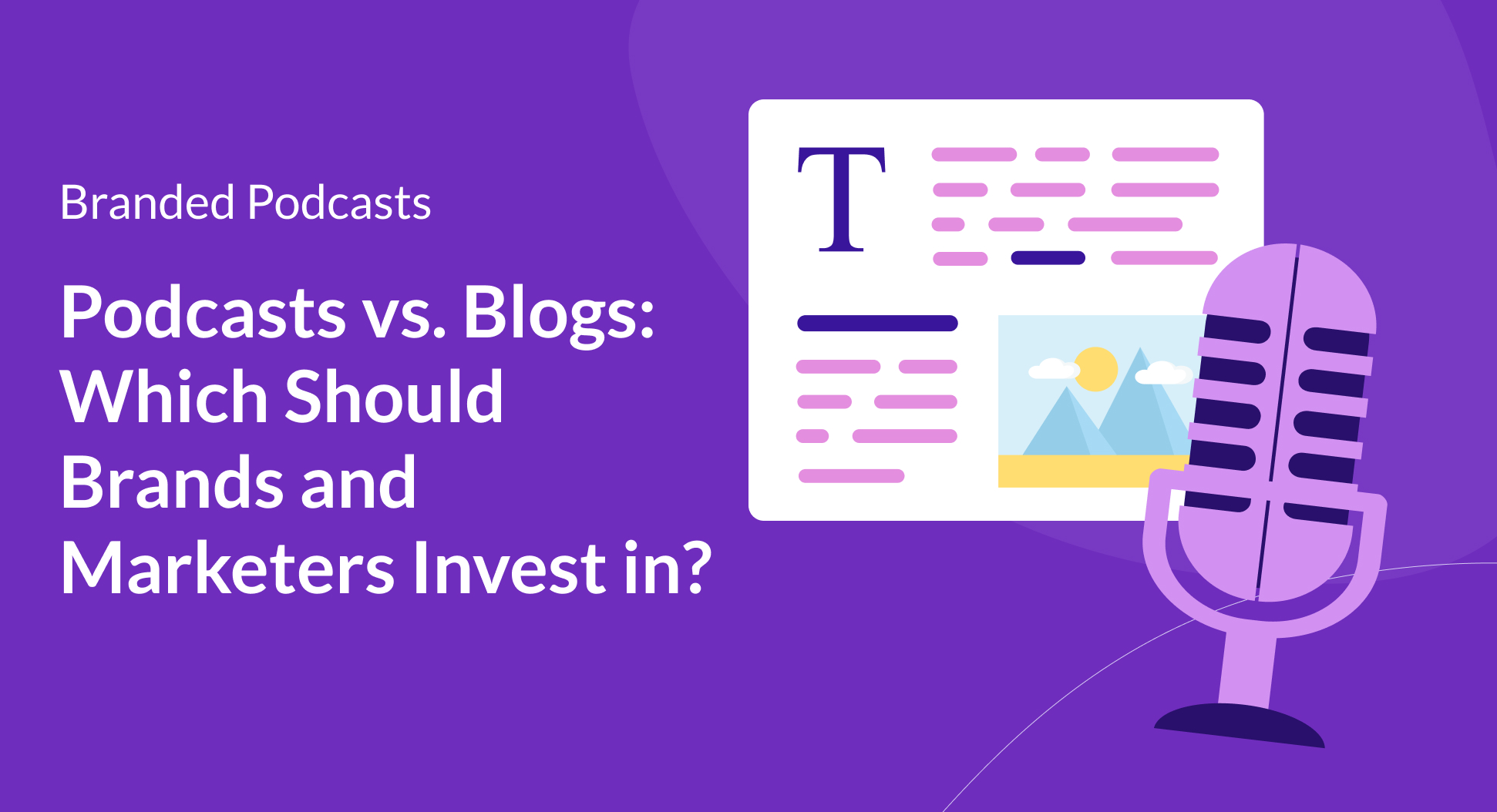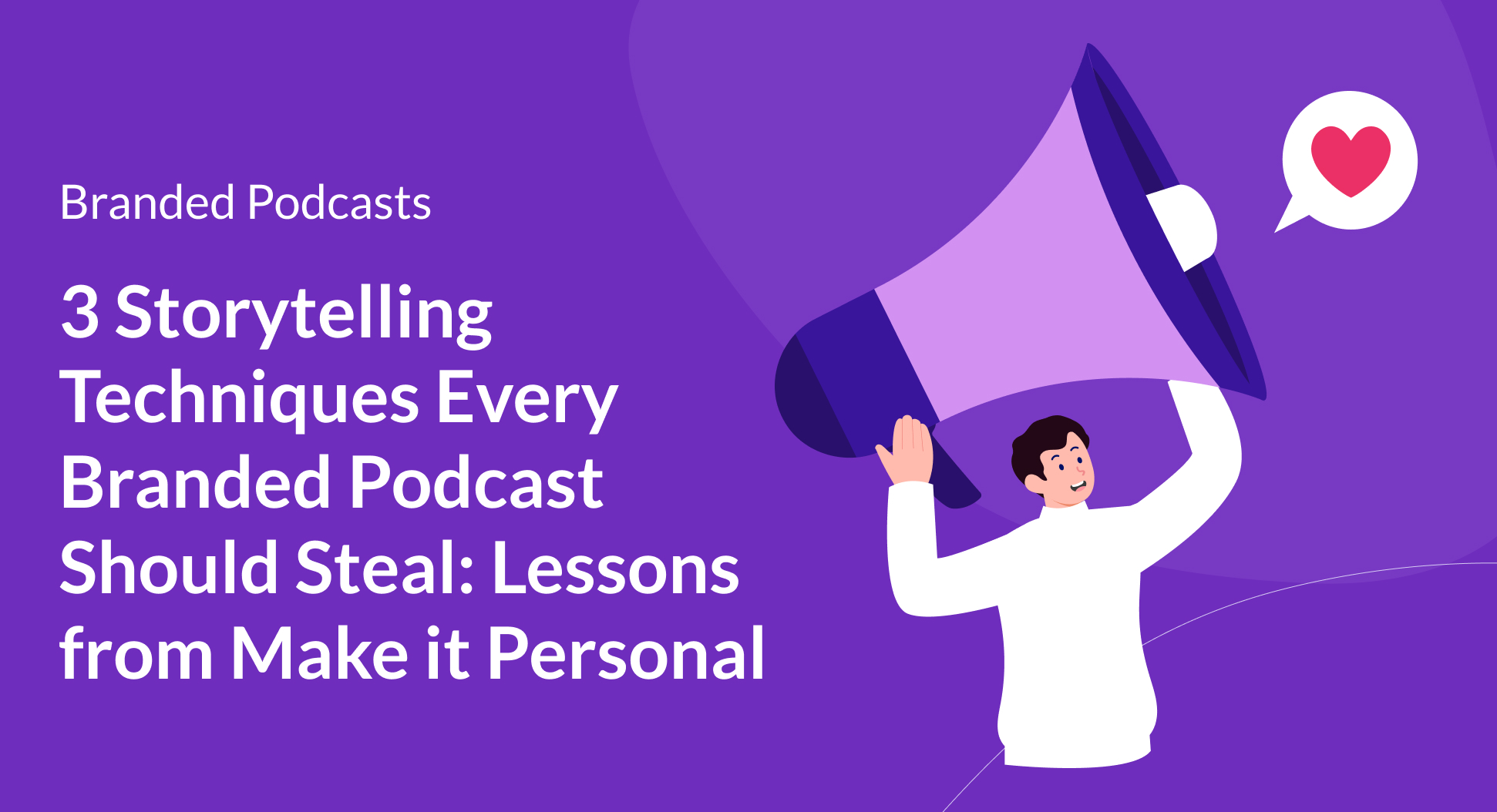Contents
Unfortunately creating a high-quality podcast is only part of the challenge of launching a successful series.
The other half is making sure it reaches the right audience.
Without a well-thought-out podcast marketing strategy, it will be a challenge to watch your show rise through the ranks (unless you’re a celebrity but sadly, that’s not the case for many of us).
In 2024, throwing tactics at the wall and seeing what sticks without a clear strategy or measurement plan in place isn’t effective. Especially for brands, creating a podcast marketing strategy will help instill confidence and turn your content team into podcast marketers in no time.
Because podcast marketing is a relatively new arena with quite a few unknowns, we’ve created a seven-step guide to creating a podcast marketing strategy you and your team will love.
1. Identify the goal of your podcast
When you first create your podcast, you likely have some goals you’d like to achieve. Whether this be lead generation, brand awareness, or thought leadership, you’ll want to nail down exactly what you hope to get out of your series.
Your podcast goal should only be one to two sentences long. If you go over two sentences, you’re probably trying to achieve an unrealistic amount with your podcast and you risk confusing your messaging with all the different goals you’re trying to hit.
Here are some common podcast goals to inspire you:
- Brand awareness
- Credibility/thought leadership
- Relationship building
- Partnerships
- Lead generation
When you write out your goal, it might look something like:
- “To generate awareness and establish credibility within the fitness and wellness industry.”
- “To build industry relationships with different fitness influencers that have over 10K followers across all social media platforms.”
This is an example of a broader and slightly more specific goal. The route you choose will ultimately depend on your show and what you’re trying to achieve.
Quill Tip: If you’re interested in optimizing your podcast goal-setting strategy, download CoHost’s free Podcast Goal Setting Template.
2. Define your target listener persona
Now that you know what you’re trying to achieve, you’ll need to define who you’re trying to reach.
When developing your ideal listener persona, the more specific the better. To help you get there, you can start analyzing existing customer data. Analyze purchase histories, feedback, and interactions to gain insights into their preferences and behaviors.
We also suggest looking into data like:
- Age
- Fears
- Gender
- Budget
- Hobbies
- Location
- Interests
- Lifestyle
- Education
- Pain Points
- Social Causes
- Socioeconomic Status
- Industry and Occupation
- Total Market (How many potential listeners there are that fit your profile. This metric will help you estimate your potential audience size)
Ultimately, defining your target listeners will help you authentically connect with them via their pain points, interests, challenges, and preferences. This exercise will also help you reach target listeners where they already live online rather than pulling them to where you are.
For example, if you want to reach a primarily female, Gen Z audience, you’re much more likely to find them on TikTok than Facebook. With this information in mind, you’ll also be able to identify forums and communities they’re likely a part of and influencers they trust.
3. Establish your podcast KPIs (Key Performance Indicators)
How will you measure the success of your podcast? This is where KPIs (key performance indicators) come into play.
If you don’t set KPIs for yourself, then you’ll lack the ability to effectively measure your podcast’s performance over time and observe whether or not it’s achieving the goal(s) that you set out to achieve initially.
Here are some common metrics you can use to quantify your podcast’s performance:
- Downloads
- Unique listeners
- Average consumption rate
- Audience demographic data (i.e., location, age, lifestyle, social media consumption habits)
- Social media engagement
- Website engagement
- Webinars, events, and newsletter sign-ups
- Downloadables, like whitepapers or reports
- Leads/conversions
Most of these metrics (1-4) can be found in either your hosting platform or through the listening app where your podcast lives (Apple, Spotify, Amazon, etc.). The remaining KPIs can be found through other tools such as Google Analytics and social media analytics.
When setting your KPIs, try to be as realistic as possible but also set a healthy challenge for yourself.
Here are a couple of examples:
- Reach a 75% consumption rate for my first season
- Generate 10 leads from my podcast over the next quarter
- Increase my downloads by 25% this year
4. Create a list of all of your marketing tactics
Now let’s dive into which tactics you’ll use to achieve your goal(s) and KPIs.
To do this, think about where your target listeners already live online. Then, create a list of all the tactics and channels you’ll be using to get your podcast in front of the right eyes (and ears).
These channels can be both paid and organic, for example:
Paid platforms:
Organic platforms:
- Social media
- Newsletters
- Podcast guests
- Podcast directories
- Forms and communities
As a brand, you likely have established marketing channels that you know reach your desired audience. Leverage those! We see too many brands trying to create podcast-specific tactics and channels and they end up putting their show in a podcast silo. Use an omnichannel approach and explore how you can add your podcast to existing tactics.
5. Breakdown each marketing tactic within your list
Break down each marketing tactic that you choose to use in your podcast marketing strategy, so you and your team have something to refer back to.
This is important for a couple of reasons. Namely to ensure you’re keeping consistent on each platform and that you’re tailoring the type of content you’re putting out for the platform at hand.
Let’s take X (previously Twitter) for example, it’s been proven that video posts receive 10x more engagement on X than standard text posts. You’ll also need to keep the tight character limit in mind and the platform suggests posting 3-6 times a day for optimal engagement.
Let’s compare that to LinkedIn where you’ll only want to be posting 3 times a week. You’ll also probably want to create longer, more value-driven posts that incorporate either carousels, downloadables, infographics, or videos.
That being said, each platform and channel has its best practices. While you don’t need to follow each one to a tee, you will want to ensure you’re catering your content to the platform for maximum engagement.
In your breakdown, include aspects such as:
- A description of the platform
- How you plan on using the tactic with your podcast
- Your KPIs for the tactic
- Your posting schedule
- A general breakdown of your content mix e.g. feature posts, podcast reviews, episode teasers, guest spotlights, etc;
This will keep you and your team organized and in check. For example, if you end up breaking down a list of 10+ tactics, maybe that’s a bit ambitious when you’re just starting.
If that’s the case, try picking just two or three tactics out of both your paid and organic options and start with those for the first few months to see how they perform. As you build a routine and become more knowledgeable, you can slowly add more or swap out the ones that aren’t working.
Quill Tip: Want to see where your podcast downloads are coming from? CoHost Tracking Links makes it easy to discern which tactics to nurture and which to place on the back burner.
6. Create an execution plan for each of your marketing tactics
Create individual execution plans for each tactic. These execution plans should include the steps that you or your team need to take to bring the tactic to life.
Make notes of anything like budget, approvals, access to certain accounts, payment information, or anything that could potentially create a barrier in your podcast marketing strategy.
Once you’ve done this, work on jumping through any hoops before you start executing so it can all run as smoothly as possible.
A sample execution plan could look like this:
- Receive approval for a $250 Spotify Ad budget;
- Obtain payment information;
- Create a Spotify Advertising account;
- Set targeting for Spotify Ads;
- Add all audio and visual creatives to Spotify Advertising;
- Review and receive final approvals;
- Launch a Spotify Advertising campaign.
We can already see that there are some potential areas of friction in steps 1, 2, and 6, so it’s a good idea to think through these challenges in advance.
7. Analyze the results and adjust accordingly
After a few months, it’s time to analyze the results of your podcast marketing strategy and review:
- Which areas are performing well
- What can be adjusted
- What can be removed
During this process, here are some questions to keep in mind:
- Did you hit your KPIs?
- Were you under or over the KPIs you set?
- Did you identify any other KPIs that you should add to your strategy?
- Which tactics performed well?
- Which tactics did not perform well?
- Which tactics would you like to add to your strategy and why?
Create a report to answer all of these questions and provide an argument about what should and shouldn’t change in your podcast marketing strategy.
Depending on the cadence of your podcast, reviewing your strategy every 3-6 months will ensure that it’s up to date and that you’ve given each tactic enough time to be able to tell whether or not it’s a good fit for your podcast.
If you’ve decided to change your strategy, create a copy of your current strategy and start a new one in a separate document. This will ensure that you always have documentation and the history of your podcast marketing strategies to reflect on and learn from.
Quill Tip: To learn more about podcast tracking and how to measure the real business value of your podcast, check out our blog where we dive into how to measure the performance of your series properly\.
Working with an agency
We know that creating and executing a successful podcast marketing strategy is easier said than done.
Outsourcing your podcast marketing to a podcast marketing agency will help save your team time and valuable resources. Plus, it’ll ensure that your podcast reaches the right audience and generates the results you’re looking for.
At Quill, we offer podcast marketing services that include everything from creating a custom audience growth strategy and tailored guest media kits to crafting podcast advertising campaigns and in-depth analytics reports.
Don’t let your podcast live in a silo
By following the steps outlined above, you can effectively integrate your podcast into your wider marketing efforts and start tracking the results. If you’re not seeing the results you hoped for, don’t be afraid to try out new types of content and channels. The nature of podcasting makes the medium adaptable and honestly, quite simple to repurpose into other types of content your team is working on.
If you’re interested in learning more about podcast marketing or are thinking of partnering with an agency to help grow your show, reach out to the Quill team.


.avif)



.png)

.png)




.png)
.png)
.png)
.png)